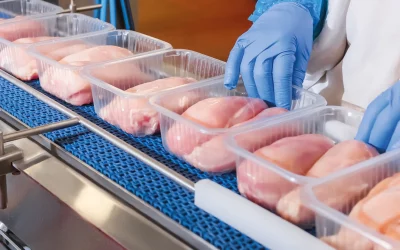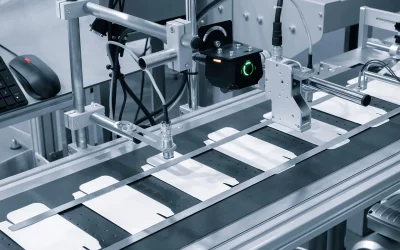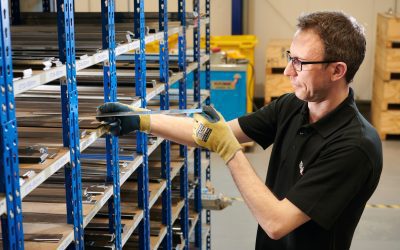What type of work does your blade do?
The first thing you need to think about is the type of work that your blade does.
There’s no hard and fast rule as to when you should change your machine blades, instead you need to take into account context – the type of cutting the blade is doing on a day-to-day basis – along with some warning signs/symptoms that you should look out for.
Another factor to consider is the quality of the blade itself.
If you’ve chosen high-quality replacement blades in the past, then you can expect them to last longer than cheaper alternatives.
How to tell that your industrial machine blade needs replacing
So, with that caveat out of the way, what are the warning signs you should be looking for?
The blade is becoming noisy and squeaky
This is one of the most obvious signs that your machine blade is nearing the end of its operational life.
If your blade begins to make noises that it never used to, or if it causes the machine to judder or vibrates, then it’s a sure thing that it’s become blunt and worn.
At this point, it’s time to replace it.
The blade is beginning to develop hairline cracks
Whilst small hairline cracks may not completely impair the operation of a blade, they are a DEFINITE sign that it’s time to replace a blade.
A dull, blunt blade will heat up much more than a sharp blade that’s in good condition. All of that heat build-up will degrade the blade, eventually resulting in hairline cracks.
As we say, a hairline crack may not on its own impair the use of a blade, but there are many people out there who would bin a blade the second they spot a hairline crack.
Play it safe and buy a new blade in the event of hairline cracks appearing on your current machine blades.
Conduct a visual inspection
This may seem like a rather obvious point, but you’d be surprised how often machine engineers overlook it!
If you think a blade may be at the end of its life, remove it from the machine and give it a close visual inspection. You’ll often be able to spot missing teeth or a build-up of pitch on the edges of the blade; both things are signs that the blade has reached the end of its operational life.
Conduct a comparison
A fairly straightforward way of seeing if your industrial machine blade is in need of replacement is to compare it against a blade which you know is sharp and in good condition.
We know that many companies keep spare machine blades in inventory, so if you’re not sure if a blade is past its ‘sell-by date’, dig a new blade out of stock and conduct a comparison.
That’s a sure-fire way of establishing the remaining lifespan of a current blade.
Inspect blade edges
Related to the point above, you should also take the time to closely inspect the edges of a blade.=
Use both bright light and a magnifying glass to check the blade edge. Such a close inspection should normally show any areas where the edge is beginning to dull – and thus affect blade cutting performance.
The blade doesn’t move consistently whilst cutting
If the blade is juddering, vibrating or snagging during operation, then you can be fairly certain that it’s in need of replacement.
Machine blades are put under a considerable amount of stress everyday – but they should continue to operate consistently – at least if they are good quality blades.
Note that this issue can also combine with other signs such as unusual burning smells and burn marks on packaging or materials which have been recently cut by the blade. In addition to a blade becoming blunt, and thus not moving consistently, it may also become worn or warped where it is fixed in place; yet another sign that it needs replacing.
The blade is moving slowly or its teeth are stripping
Should you find that a blade is cutting slower and/or you are finding that the blade is losing ‘teeth’, then this is another tell-tale sign that it’s time for a replacement blade in your machine.
Other related issues can include the need for increased feed pressure or a noticeable slowdown of feed rate. These are also signs that a blade is losing teeth, becoming blunt and is generally worn out.
How to prolong the life of your industrial machine blades
Don’t worry. You don’t need to be continually changing your industrial machine blades. In fact, if you purchase high-quality replacement blades, then you should be able to keep them operational just by following a few simple tips; simple tips such as these ones…
Keep your machine blades clean
Again, this may seem like a rather obvious point, but in a busy manufacturing or processing environment, it can be easy to overlook the cleaning of machine blades.
But, it’s well worth it.
Ensure that your machine blades are thoroughly cleaned at least two or three times a year and you’ll help them last that much longer.
Regular sharpening
Whilst high-quality machine blades will stay sharper for longer, they will still benefit from being sharpened on a periodic basis. Remember, excessive usage without regular sharpening can significantly reduce the operational lifespan of a machine blade.
Proper handling and storage
Machine blades are precision pieces of equipment. As such, they should be both handled and stored with care.
Mishandling machine blades can lead to them becoming blunt, warped and bent. Likewise, improper storage can lead to machine blades corroding, tarnishing and generally losing their structural integrity. All of which will reduce their lifespan.
If you would to ensure you get the most possible value from a machine blade, ensure it’s always stored and handled properly.
Choose MRMK blades
The easiest way to ensure you get the most possible life out of your machine blades is to use MRMK blades.
Not only are MRMK blades far better value than their OEM equivalents, but they benefit from industry-leading design and materials engineering – which all adds up to create superior machine blades.
If you want to fit your machines with the very best, long-lasting blades, choose MRMK.
Learn more about MRMK now
Find out more about industrial machine blades on the MRMK news and insights hub…
The Ultimate Guide to Blade Coatings and Their Benefits | Choosing the Right Industrial Blade Supplier for Your Operations | What Are the Different Types of Packaging Machine Knives?



